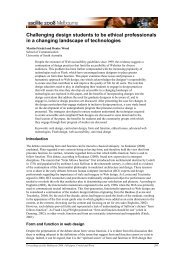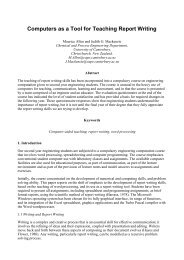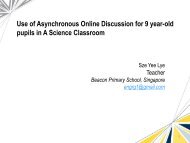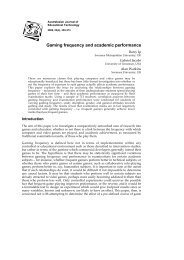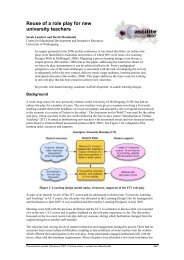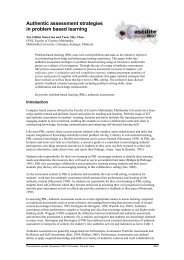INTERACT INTEGRATE IMPACT - ascilite
INTERACT INTEGRATE IMPACT - ascilite
INTERACT INTEGRATE IMPACT - ascilite
Create successful ePaper yourself
Turn your PDF publications into a flip-book with our unique Google optimized e-Paper software.
Parfenovics and Fletcher<br />
EVALUATING STREAMING MEDIA APPLICATIONS<br />
FOR HIGHER EDUCATION<br />
Introduction<br />
Roly Parfenovics and Marty Fletcher<br />
Academic Development Team, Learning Resources Division<br />
Charles Darwin University, AUSTRALIA<br />
marty.fletcher@cdu.edu.au, roly.parfenovics@.edu.au<br />
Abstract<br />
Streaming media applications are poised to make a large impact on higher education.<br />
Currently a growing number of new audio/video production and delivery applications<br />
are being packaged for and presented to higher education. One of the appeals is<br />
that the new technologies leverage existing educational practices, in particular, the<br />
traditional lecture format. Evaluation of options for implementing this technology into<br />
higher education must take into account the following: the ability to adapt existing<br />
resources, the amount of training required for educators to integrate the technology,<br />
and technical factors. These factors are backgrounded against standardization efforts<br />
by the streaming media industry. This paper describes how evaluation factors, as<br />
asserted in vendors’ claims, are being catalogued within an ongoing watching brief.<br />
Keywords<br />
Streaming media, online delivery, technology evaluation<br />
Keeping up with the moving targets of evolving technologies is no easy task, and this is particularly<br />
so in the case of applications for creating and delivering streaming multimedia. Streaming technology<br />
is becoming increasingly featured in web-based delivery of higher education (Michelich, 2002; Lynch<br />
2002, Furr, 2001) driven both by increasing availability of technologies (McCannel, 2001) and persistent<br />
budgetary pressures over the last decade to find scalable alternatives to the mass theatre lecture in<br />
undergraduate studies (Roberts, 1993).<br />
The integration of streaming technology into higher education is occurring only after developers of<br />
streaming media authoring and delivery applications have overcome some of the initial impediments,<br />
such as complex editing and other processing procedures, to the technology, (Furr, 2001). There has also<br />
been considerable impact on higher education’s network infrastructures, effecting even institutions which<br />
do not deploy streaming technologies within their educational delivery strategies, as when institutional<br />
networks become overloaded with streaming content accessed by students for leisure as well as learning<br />
(Carlson, 2001).<br />
Technology choices made to support flexible delivery often take place without needs assessment and<br />
planning for evaluation; technologies are often implemented based on availability, rather than as an<br />
outcome of systematic design (Compora, 2003). This paper offers a record and synthesis of information<br />
obtained from streaming application vendors, the IT and higher education press, and the educational<br />
technology literature, which must be monitored, considered and evaluated if an institution wishes to<br />
make intelligent choices in acquiring streaming technologies. It describes and recommends criteria for<br />
evaluating streaming media authoring and delivery tools, against the tenuous background of IT industry<br />
developments that will determine returns on investment for investment and training choices made in<br />
pursuit of enriched flexible learning delivery.<br />
674



